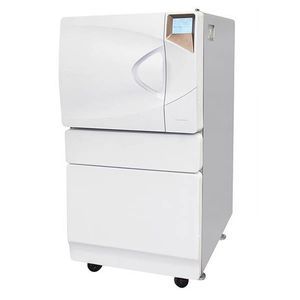
- Hygiene
- Sterilization
- Medical sterilizer
- Shinva Medical Instrument
Formaldehyde sterilizer FS-130medicalfloor-standingautomatic
Add to favorites
Compare this product
Characteristics
- Applications
- medical
- Sterilization procedure
- formaldehyde
- Configuration
- floor-standing
- Function
- automatic
- Temperature range
60 °C, 78 °C
(140 °F, 172.4 °F)- Sterilization cycle time
10 min, 30 min
Description
The sterilization principle of formaldehyde is a non-specific alkylation, in which formaldeyde molecules act directly on the reactive groups on nucleic acid and protein molecules of bacteria, causing them to alkylate and thus leading to the death of microorganisms.
Formaldehyde Sterilizer consists of sterilization chamber, vacuum system, sterilant injection system, vaporization system, automatic control system, etc. It has two sterilization procedures, 60℃and 78℃,and is suitable for sterilization of heat-sensitive medical devices.
Formaldehyde sterilization process and characteristics
Process flow
Formaldehyde sterilization is similar to the process curve of high-temperature pressure steam sterilization, compared with formaldehyde sterilization pressure of negative pressure and lower sterilization temperature.
Process features
Combined the advantages of pressure steam and low temperature chemical sterilization.
Steam sterilization characteristics:
Steam has strong penetration and uniformity,and sterilization is not limited by the structure and cavity of the articles.
Chemical sterilization characteristics:
Chemical sterilization uses the chemical properties of the sterilizing agent to sterilize at low temperature and under vacuum, and can be used to sterilize instruments that are not resistant to high temperature.
Formaldehyde sterilization:
The chemical nature of formaldehyde and the penetration of steam are used to sterilize in low temperature environment.
The amount of formaldehyde is automatically adjusted according to the load.
Catalogs
No catalogs are available for this product.
See all of Shinva Medical Instrument‘s catalogsRelated Searches
- Shinva-shinva sterilizer
- Shinva-shinva steam sterilizer
- Shinva-shinva medical sterilizer
- Benchtop autoclave
- 2-door cupboard
- Shinva-shinva automatic sterilizer
- Stainless steel autoclave
- 1-door cupboard
- Single-module cabinet
- Medical equipment cabinet
- Ultrasonic cleaner
- Front-loading sterilizer
- Shinva-shinva sterilization container
- Dental autoclave
- Shinva-shinva instrument sterilization container
- Floor-standing autoclave
- Vertical autoclave
- Autoclave with touchscreen
- Stainless steel ultrasonic cleaner
- Endoscopy cabinet
*Prices are pre-tax. They exclude delivery charges and customs duties and do not include additional charges for installation or activation options. Prices are indicative only and may vary by country, with changes to the cost of raw materials and exchange rates.













